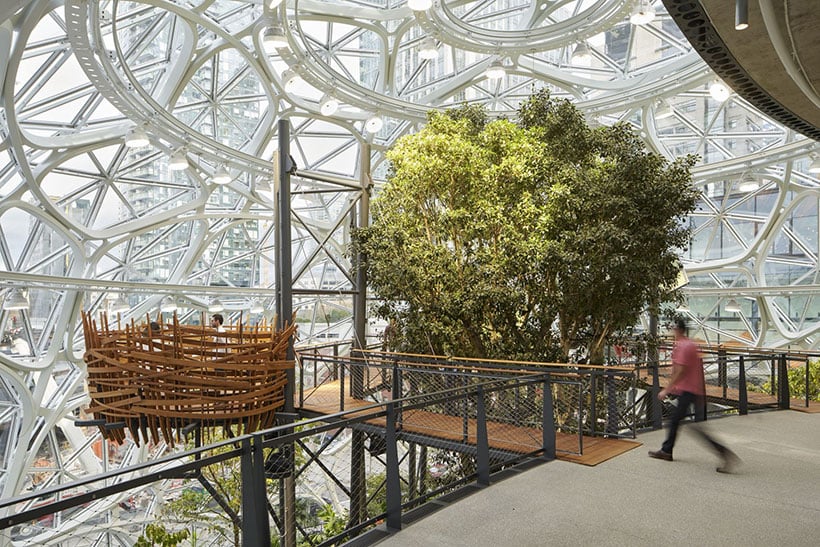The growing practice of biophilic design in architecture is all about maintaining a connection to nature and light through a building. Because glass is the most popular transparent building material used in contemporary architecture and building construction, it is a very popular choice for biophilic design.
What is Biophilia?
Biophilia is a concept that suggests human beings have a natural desire to be connected to and immersed in nature. The growing practice of biophilic design in architecture is all about maintaining a connection to nature and light through a building, whether with views outside through the exterior of a building or by physically bringing nature inside the building.
Because glass is the most popular transparent building material used in contemporary architecture and building construction, it is a very popular choice for biophilic design and readily supports the inclusion of views of nature and the placement and survival of plant life inside buildings. Advancements in energy efficiency and thermal insulation performance also have made glass a sustainable choice that complements the philosophy behind biophilic design.
Glass and Biophilic Design
Research has shown that increased daylight in the workplace increases worker satisfaction and overall performance. As we reconsider what design principles are most valuable for today’s in-person offices, we can expect biophilia to play a major role in designing the workplaces of the future to help attract workers and support increased productivity and happiness at work.
Glass is arguably the most effective façade material when it comes to increasing interior daylight. When a facade employs biophilic design techniques and materials like glass that can increase daylight, occupants will enjoy more interior daylighting and views of nature.
Glass is also an effective material for making interior spaces private without closing off views to exteriors and each other, allowing for separate spaces that are engaging yet hygienic in a pandemic-era world. Innovations in electrochromic glass can even turn glass opaque with a simple flip of a switch, creating temporary privacy when needed and otherwise allowing for maximum views and connection.

Low-E Coatings
Low-emissivity (low-e) coatings can play an important role in supporting indoor plant life in biophilic buildings by allowing for the right kind of light or wavelength – the kind that supports plant growth – inside without compromising the amount of visible light that is transmitted or allowing for too much solar heat.
The color rendering index (CRI) is a qualitative measure that evaluates how true colors are being viewed, and the goal of biophilic design is to ensure that the views through a window are as true to nature as possible. Many glasses with low-e coatings will maintain a neutral appearance, allowing for better thermal performance and increased energy efficiency while retaining a higher CRI value for the preservation of true color views.
Insulation Performance and Energy Efficiency
Glass is often misunderstood as insufficient when it comes to insulation performance, but innovations in glass technology have led to new products that can easily support principles of biophilic design while also functioning as a high-quality façade material. Vacuum insulating glass (VIG) combines vacuum technology and low-e coatings into an insulating glass unit (IGU) with exceptional insulation performance, rivaling that of traditional walls while simultaneously allowing for exterior views.
The use of glass facades to increase daylight will also reduce the demand for artificial lighting, which is an important consideration for energy efficiency. Biophilia and sustainability go hand in hand, and thanks to advancements in glass technology, glass can accomplish both goals.

Biophilia in Urban Areas
Even in large cities where green views are more challenging to access, biophilic design has adapted for urban settings. In this case, building occupants can benefit from views of other people living social lives outdoors, and the psychological benefits of this are quite significant.
As designers work to develop biophilic buildings in urban areas, architects have found innovative ways to bring green spaces into and even onto buildings, sometimes by installing greenery and plant life on facades. Using glass as a façade material in tandem with greenery installations allows for these innovative biophilic designs to be seen from inside as well.
As cities continue to grow and more workers return to in-person workspaces, the demand for biophilic design will only increase. Glass facades are an excellent way to design with biophilia in mind. As a building façade material, glass can help support interior plant life, increase natural views and daylighting for occupant satisfaction, and even improve energy efficiency to support a project’s sustainability, which goes hand-in-hand with the desire to appreciate and protect our natural environment.
For additional information about designing with Vitro Architectural Glass, please visit vitroglazings.com.
For any other glass questions, please contact Vitro Glass or call 1-855-VTRO-GLS (1-855-887-6457).
Updated on March 31, 2022




